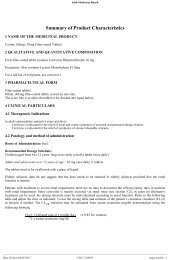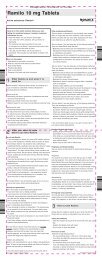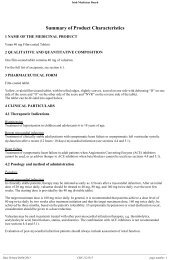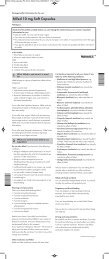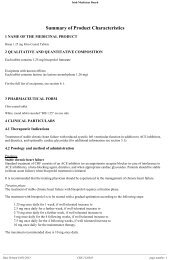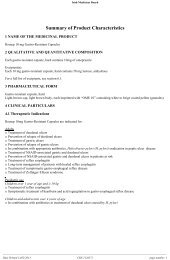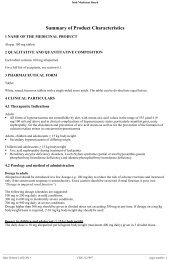Download Flucol 2mg/ml Solution for Infusion SPC here - Rowex Ltd
Download Flucol 2mg/ml Solution for Infusion SPC here - Rowex Ltd
Download Flucol 2mg/ml Solution for Infusion SPC here - Rowex Ltd
You also want an ePaper? Increase the reach of your titles
YUMPU automatically turns print PDFs into web optimized ePapers that Google loves.
Irish Medicines Board1 NAME OF THE MEDICINAL PRODUCT<strong>Flucol</strong> 2 mg/<strong>ml</strong> <strong>Solution</strong> <strong>for</strong> <strong>Infusion</strong>.Summary of Product Characteristics2 QUALITATIVE AND QUANTITATIVE COMPOSITIONEach 50 <strong>ml</strong> solution <strong>for</strong> infusion contains 100 mg fluconazole.Each 100 <strong>ml</strong> solution <strong>for</strong> intravenous infusion contains 200 mg fluconazole.Each 200 <strong>ml</strong> solution <strong>for</strong> intravenous infusion contains 400 mg fluconazole.Each <strong>ml</strong> contains 2 mg of fluconazoleExcipients: Each <strong>ml</strong> also contains 9mg sodium chloride (equivalent to 0.154 mmol sodium).For the full list of excipients, see section 6.1.3 PHARMACEUTICAL FORM<strong>Solution</strong> <strong>for</strong> infusionClear, colourless solution with no visible particles.4 CLINICAL PARTICULARS4.1 Therapeutic Indications<strong>Flucol</strong> is indicated in the following fungal infections (see section 5.1).<strong>Flucol</strong> is indicated in adults <strong>for</strong> the treatment of:• Cryptococcal meningitis (see section 4.4).• Coccidioidomycosis (see section 4.4).• Invasive candidiasis.• Mucosal candidiasis including oropharyngeal, oesophageal candidiasis, candiduria and chronic mucocutaneouscandidiasis.• Chronic oral atrophic candidiasis (denture sore mouth) if dental hygiene or topical treatment are insufficient.<strong>Flucol</strong> is indicated in adults <strong>for</strong> the prophylaxis of:• Relapse of cryptococcal meningitis in patients with high risk of recurrence.• Relapse of oropharyngeal or oesophageal candidiasis in patients infected with HIV who are at high risk ofexperiencing relapse.• Prophylaxis of candidal infections in patients with prolonged neutropenia (such as patients with haematologicalmalignancies receiving chemotherapy or patients receiving Hematopoietic Stem Cell Transplantation (see section 5.1)).<strong>Flucol</strong> is indicated in term newborn infants, infants, toddlers, children, and adolescents aged from 0 to 17 years old:<strong>Flucol</strong> is used <strong>for</strong> the treatment of mucosal candidiasis (oropharyngeal, oesophageal), invasive candidiasis,cryptococcal meningitis and the prophylaxis of candidal infections in immunocompromised patients. <strong>Flucol</strong> can beused as maintenance therapy to prevent relapse of cryptococcal meningitis in children with high risk of reoccurrence(see section 4.4).______________________________________________________________________________________________________________________Date Printed 21/06/2012 CRN 2107637 page number: 1
Irish Medicines BoardTherapy may be instituted be<strong>for</strong>e the results of the cultures and other laboratory studies are known; however, oncethese results become available, anti-infective therapy should be adjusted accordingly.Consideration should be given to official guidance on the appropriate use of antifungals.4.2 Posology and method of administrationPosologyThe dose should be based on the nature and severity of the fungal infection. Treatment of infections requiring multipledosing should be continued until clinical parameters or laboratory tests indicate that active fungal infection hassubsided. An inadequate period of treatment may lead to recurrence of active infection.AdultsIndications Posology Duration of treatmentCryptococcosis - Treatment ofcryptococcalmeningitis- Maintenance therapyto prevent relapse ofcryptococcalmeningitis in patientswith high risk ofrecurrenceLoading dose: 400mg on Day 1.Subsequent dose:200 mg to 400 mgdailyUsually at least 6 to8 weeks.In life threateninginfections the daily dosecan be increased to 800mg200 mg daily Indefinitely at a daily doseof 200 mgCoccidioidomycosis 200 mg to 400 mg 11 months up to24 months or longerdepending on the patient.800 mg daily may beconsidered <strong>for</strong> someinfections and especially<strong>for</strong> meningeal disease.Invasive candidiasis Loading dose: 800mg on Day 1.Subsequent dose:400 mg dailyTreatment ofmucosal candidiasis- Oropharyngealcandidiasis- OesophagealcandidiasisLoading dose: 200mg to 400 mg onDay 1.Subsequent dose:100 mg to 200 mgdailyLoading dose: 200mg to 400 mg onDay 1.Subsequent dose:100 mg to 200 mgdailyIn general, t<strong>here</strong>commended duration oftherapy <strong>for</strong> candidemia is<strong>for</strong> 2 weeks after firstnegative blood cultureresult and resolution ofsigns and symptomsattributable to candidemia.7 to 21 days (untiloropharyngeal candidiasisis in remission).Longer periods may beused in patients withseverely compromisedimmune function.14 to 30 days (untiloesophageal candidiasis isin remission).Longer periods may beused in patients withseverely compromisedimmune function.- Candiduria 200 mg to 400 mg 7 to 21 days. Longer______________________________________________________________________________________________________________________Date Printed 21/06/2012 CRN 2107637 page number: 2
Irish Medicines BoardPrevention of relapse ofmucosal candidiasis inpatients infected withHIV who are at highrisk of experiencingrelapseProphylaxis of candidalinfections in patientswith prolongedneutropeniaSpecial populations- Chronic atrophiccandidiasis- Chronicmucocutaneouscandidiasis- Oropharyngealcandidiasis- Oesophagealcandidiasisdailyperiods may be used inpatients with severelycompromised immunefunction.50 mg daily 14 days50 mg to 100 mgdaily100 mg to 200 mgdaily or 200 mg3 times per week100 mg to 200 mgdaily or200 mg 3 timesUp to 28 days. Longerperiods depending on boththe severity of infection orunderlying immunecompromisation andinfectionAn indefinite period <strong>for</strong>patients with chronicimmune suppressionAn indefinite period <strong>for</strong>patients with chronicimmune suppressionper week200 mg to 400 mg Treatment should startseveral days be<strong>for</strong>e theanticipated onset ofneutropenia and continue<strong>for</strong> 7 days after recoveryfrom neutropenia after theneutrophil count risesabove 1000 cells per mm 3 .ElderlyDosage should be adjusted based on the renal function (see “Renal impairment”).Renal impairmentFluconazole is predominantly excreted in the urine as unchanged active substance. No adjustments in single dosetherapy are necessary. In patients (including paediatric population) with impaired renal function who will receivemultiple doses of fluconazole, an initial dose of 50 mg to 400 mg should be given, based on the recommended dailydose <strong>for</strong> the indication. After this initial loading dose, the daily dose (according to indication) should be based on thefollowing table:Creatinine clearance (<strong>ml</strong>/min) Percent of recommended dose> 50 100%≤ 50 (no dialysis) 50%Regular dialysis100% after each dialysisPatients on regular dialysis should receive 100% of the recommended dose after each dialysis; on non-dialysis days,patients should receive a reduced dose according to their creatinine clearance.Hepatic impairmentLimited data are available in patients with hepatic impairment. T<strong>here</strong><strong>for</strong>e, fluconazole should be administered withcaution to patients with liver dysfunction (see sections 4.4 and 4.8).Paediatric populationA maximum dose of 400 mg daily should not be exceeded in paediatric population.As with similar infections in adults, the duration of treatment is based on the clinical and mycological response. <strong>Flucol</strong>is administered as a single daily dose.______________________________________________________________________________________________________________________Date Printed 21/06/2012 CRN 2107637 page number: 3
Irish Medicines BoardFor paediatric patients with impaired renal function, see dosing in “Renal impairment”. The pharmacokinetics offluconazole has not been studied in paediatric population with renal insufficiency (<strong>for</strong> “Term newborn infants” whooften exhibit primarily renal immaturity please see below).Infants, toddlers and children (from 28 days to 11 years old):Indication Posology Recommendations- Mucosal candidiasis Initial dose: 6 mg/kgSubsequent dose: 3 mg/kg dailyInitial dose may be used on the firstday to achieve steady state levelsmore rapidly.- Invasive candidiasis- Cryptococcal meningitisDose: 6 to 12 mg/kg daily Depending on the severity of thedisease- Maintenance therapy to preventrelapse of cryptococcal meningitisin children with high risk ofrecurrence- Prophylaxis of Candida inimmunocompromised patientsDose: 6 mg/kg dailyDose: 3 to 12 mg/kg dailyDepending on the severity of thediseaseDepending on the extent andduration of the induced neutropenia(see Adults posology)Adolescents (from 12 to 17 years old):Depending on the weight and pubertal development, the prescriber would need to assess which posology (adults orchildren) is the most appropriate. Clinical data indicate that children have a higher fluconazole clearance than observed<strong>for</strong> adults. A dose of 100, 200 and 400 mg in adults corresponds to a 3, 6 and 12 mg/kg dose in children to obtain acomparable systemic exposure.Term newborn infants (0 to 27 days):Neonates excrete fluconazole slowly. T<strong>here</strong> are few pharmacokinetic data to support this posology in term newborninfants (see section 5.2).Age group Posology RecommendationsTerm newborn infants(0 to 14 days)The same mg/kg dose as <strong>for</strong> infants,toddlers and children should begiven every 72 hours.A maximum dose of 12 mg/kg every 72 hoursshould not be exceeded.Term newborn infants(from 15 to 27 days)Method of administrationFluconazole may be administered either orally or by intravenous infusion, the route being dependent on the clinicalstate of the patient. On transferring from the intravenous to the oral route, or vice versa, t<strong>here</strong> is no need to change thedaily dose.Intravenous infusion should be administrated at a rate not exceeding 10 <strong>ml</strong>/minute. <strong>Flucol</strong> is <strong>for</strong>mulated in sodiumchloride 9 mg/<strong>ml</strong> (0.9%) solution <strong>for</strong> infusion, each 200 mg (100 <strong>ml</strong> bottle) containing 15 mmol each of sodium (Na+)and Cl ̄. Because <strong>Flucol</strong> is available as a dilute sodium chloride solution, in patients requiring sodium or fluidrestriction, consideration should be given to the rate of fluid administration.For instruction on handling of the product, see section 6.6.4.3 ContraindicationsThe same mg/kg dose as <strong>for</strong> infants,toddlers and children should begiven every 48 hours.A maximum dose of 12 mg/kg every 48 hoursshould not be exceeded.Hypersensitivity to the active substance, to related azole substances or to any of the excipients listed in section 6.1.______________________________________________________________________________________________________________________Date Printed 21/06/2012 CRN 2107637 page number: 4
Irish Medicines BoardCoadministration of terfenadine is contraindicated in patients receiving <strong>Flucol</strong> at multiple doses of 400 mg per day orhigher based upon results of a multiple dose interaction study. Coadministration of other medicinal products known toprolong the QT interval and which are metabolised via the cytochrome P450 (CYP) 3A4 such as cisapride, astemizole,pimozide, quinidine and erythromycin are contraindicated in patients receiving fluconazole (see sections 4.4 and 4.5).4.4 Special warnings and precautions <strong>for</strong> useTinea capitisFluconazole has been studied <strong>for</strong> treatment of tinea capitis in children. It was shown not to be superior to griseofulvinand the overall success rate was less than 20%. T<strong>here</strong><strong>for</strong>e, fluconazole should not be used <strong>for</strong> tinea capitis.CryptococcosisThe evidence <strong>for</strong> efficacy of fluconazole in the treatment of cryptococcosis of other sites (e.g. pulmonary and cutaneouscryptococcosis) is limited, which prevents dosing recommendations.Deep endemic mycosesThe evidence <strong>for</strong> efficacy of fluconazole in the treatment of other <strong>for</strong>ms of endemic mycoses such asparacoccidioidomycosis, lymphocutaneous sporotrichosis and histoplasmosis is limited, which prevents specific dosingrecommendations.Renal systemFluconazole should be administered with caution to patients with renal dysfunction (see section 4.2).Hepatobiliary systemFluconazole should be administered with caution to patients with liver dysfunction.Fluconazole has been associated with rare cases of serious hepatic toxicity including fatalities, primarily in patientswith serious underlying medical conditions. In cases of fluconazole associated hepatotoxicity, no obvious relationshipto total daily dose, duration of therapy, sex or age of patient has been observed. Fluconazole hepatotoxicity has usuallybeen reversible on discontinuation of therapy.Patients who develop abnormal liver function tests during fluconazole therapy must be monitored closely <strong>for</strong> thedevelopment of more serious hepatic injury.The patient should be in<strong>for</strong>med of suggestive symptoms of serious hepatic effect (important asthenia, anorexia,persistent nausea, vomiting and jaundice). Treatment of fluconazole should be immediately discontinued and thepatient should consult a physician.Cardiovascular systemSome azoles, including fluconazole, have been associated with prolongation of the QT interval on theelectrocardiogram. During post-marketing surveillance, t<strong>here</strong> have been very rare cases of QT prolongation andtorsades de pointes in patients taking fluconazole. These reports included seriously ill patients with multipleconfounding risk factors, such as structural heart disease, electrolyte abnormalities and concomitant treatment that mayhave been contributory.<strong>Flucol</strong> should be administered with caution to patients with these potentially proarrhythmic conditions.Coadministration of other medicinal products known to prolong the QT interval and which are metabolised via thecytochrome P450 (CYP) 3A4 are contraindicated (see sections 4.3 and 4.5).HalofantrineHalofantrine has been shown to prolong QTc interval at the recommended therapeutic dose and is a substrate ofCYP3A4. The concomitant use of fluconazole and halofantrine is t<strong>here</strong><strong>for</strong>e not recommended (see section 4.5).Dermatological reactionsPatients have rarely developed exfoliative cutaneous reactions, such as Stevens-Johnson syndrome and toxic epidermalnecrolysis, during treatment with fluconazole. AIDS patients are more prone to the development of severe cutaneousreactions to many medicinal products. If a rash, which is considered attributable to fluconazole, develops in a patient______________________________________________________________________________________________________________________Date Printed 21/06/2012 CRN 2107637 page number: 5
Irish Medicines Boardtreated <strong>for</strong> a superficial fungal infection, further therapy with this medicinal product should be discontinued. If patientswith invasive/systemic fungal infections develop rashes, they should be monitored closely and fluconazolediscontinued if bullous lesions or erythema multi<strong>for</strong>me develop.HypersensitivityIn rare cases anaphylaxis has been reported (see section 4.3).Cytochrome P450Fluconazole is a potent CYP2C9 inhibitor and a moderate CYP3A4 inhibitor. Fluconazole is also an inhibitor ofCYP2C19. Fluconazole treated patients who are concomitantly treated with medicinal products with a narrowtherapeutic window metabolised through CYP2C9, CYP2C19 and CYP3A4, should be monitored (see section 4.5).TerfenadineThe coadministration of fluconazole at doses lower than 400 mg per day with terfenadine should be carefullymonitored (see sections 4.3 and 4.5).ExcipientsThis medicinal product contains 0.154 mmol sodium per <strong>ml</strong>. To be taken into consideration by patients on a controlledsodium diet.4.5 Interaction with other medicinal products and other <strong>for</strong>ms of interactionConcomitant use of the following other medicinal products is contraindicated:Cisapride: T<strong>here</strong> have been reports of cardiac events including torsades de pointes in patients to whom fluconazole andcisapride were coadministered. A controlled study found that concomitant fluconazole 200 mg once daily and cisapride20 mg four times a day yielded a significant increase in cisapride plasma levels and prolongation of QTc interval.Concomitant treatment with fluconazole and cisapride is contraindicated (see section 4.3).Terfenadine: Because of the occurrence of serious cardiac dysrhythmias secondary to prolongation of the QTc intervalin patients receiving azole antifungals in conjunction with terfenadine, interaction studies have been per<strong>for</strong>med. Onestudy at a 200 mg daily dose of fluconazole failed to demonstrate a prolongation in QTc interval. Another study at a400 mg and 800 mg daily dose of fluconazole demonstrated that fluconazole taken in doses of 400 mg per day orgreater significantly increases plasma levels of terfenadine when taken concomitantly. The combined use offluconazole at doses of 400 mg or greater with terfenadine is contraindicated (see section 4.3). The coadministration offluconazole at doses lower than 400 mg per day with terfenadine should be carefully monitored.Astemizole: Concomitant administration of fluconazole with astemizole may decrease the clearance of astemizole.Resulting increased plasma concentrations of astemizole can lead to QT prolongation and rare occurrences of torsadesde pointes. Coadministration of fluconazole and astemizole is contraindicated (see section 4.3).Pimozide: Although not studied in vitro or in vivo, concomitant administration of fluconazole with pimozide may resultin inhibition of pimozide metabolism. Increased pimozide plasma concentrations can lead to QT prolongation and rareoccurrences of torsades de pointes. Coadministration of fluconazole and pimozide is contraindicated (see section 4.3).Quinidine: Although not studied in vitro or in vivo, concomitant administration of fluconazole with quinidine mayresult in inhibition of quinidine metabolism. Use of quinidine has been associated with QT prolongation and rareoccurrences of torsades de pointes. Coadministration of fluconazole and quinidine is contraindicated (see section 4.3).Erythromycin: Concomitant use of fluconazole and erythromycin has the potential to increase the risk of cardiotoxicity(prolonged QT interval, torsades de pointes) and consequently sudden heart death. Coadministration of fluconazole anderythromycin is contraindicated (see section 4.3).Concomitant use of the following other medicinal products cannot be recommended:Halofantrine: Fluconazole can increase halofantrine plasma concentration due to an inhibitory effect on CYP3A4.______________________________________________________________________________________________________________________Date Printed 21/06/2012 CRN 2107637 page number: 6
Irish Medicines BoardConcomitant use of fluconazole and halofantrine has the potential to increase the risk of cardiotoxicity (prolonged QTinterval, torsades de pointes) and consequently sudden heart death. This combination should be avoided (see section4.4).Concomitant use of the following other medicinal products lead to precautions and dose adjustments:The effect of other medicinal products on fluconazoleRifampicin: Concomitant administration of fluconazole and rifampicin resulted in a 25% decrease in the AUC and a20% shorter half-life of fluconazole. In patients receiving concomitant rifampicin, an increase of the fluconazole doseshould be considered.Interaction studies have shown that when oral fluconazole is coadministered with food, cimetidine, antacids orfollowing total body irradiation <strong>for</strong> bone marrow transplantation, no clinically significant impairment of fluconazoleabsorption occurs.The effect of fluconazole on other medicinal productsFluconazole is a potent inhibitor of cytochrome P450 (CYP) isoenzyme 2C9 and a moderate inhibitor of CYP3A4.Fluconazole is also an inhibitor of the isozyme CYP2C19. In addition to the observed/documented interactionsmentioned below, t<strong>here</strong> is a risk of increased plasma concentration of other compounds metabolized by CYP2C9 andCYP3A4 coadministered with fluconazole. T<strong>here</strong><strong>for</strong>e, caution should be exercised when using these combinations andthe patients should be carefully monitored. The enzyme inhibiting effect of fluconazole persists 4-5 days afterdiscontinuation of fluconazole treatment due to the long half-life of fluconazole (see section 4.3).Alfentanil: During concomitant treatment with fluconazole (400 mg) and intravenous alfentanil (20 µg/kg) in healthyvolunteers the alfentanil AUC 10 increased 2-fold, probably through inhibition of CYP3A4. Dose adjustment ofalfentanil may be necessary.Amitriptyline, nortriptyline: Fluconazole increases the effect of amitriptyline and nortriptyline. 5-nortriptyline and/or S-amitriptyline may be measured at initiation of the combination therapy and after one week. Dose ofamitriptyline/nortriptyline should be adjusted, if necessary.Amphotericin B: Concurrent administration of fluconazole and amphotericin B in infected normal andimmunosuppressed mice showed the following results: a small additive antifungal effect in systemic infection with C.albicans, no interaction in intracranial infection with Cryptococcus neo<strong>for</strong>mans, and antagonism of the two medicinalproducts in systemic infection with A. fumigatus. The clinical significance of results obtained in these studies isunknown.Anticoagulants: In post-marketing experience, as with other azole antifungals, bleeding events (bruising, epistaxis,gastrointestinal bleeding, hematuria, and melena) have been reported, in association with increases in prothrombin timein patients receiving fluconazole concurrently with warfarin. During concomitant treatment with fluconazole andwarfarin the prothrombin time was prolonged up to 2-fold, probably due to an inhibition of the warfarin metabolismthrough CYP2C9. In patients receiving coumarin-type anticoagulants concurrently with fluconazole the prothrombintime should be carefully monitored. Dose adjustment of warfarin may be necessary.Benzodiazepines (short acting), i.e. midazolam, triazolam: Following oral administration of midazolam, fluconazoleresulted in substantial increases in midazolam concentrations and psychomotor effects. Concomitant intake offluconazole 200 mg and midazolam 7.5 mg orally increased the midazolam AUC and half-life 3.7-fold and 2.2-fold,respectively. Fluconazole 200 mg daily given concurrently with triazolam 0.25 mg orally increased the triazolam AUCand half-life 4.4-fold and 2.3-fold, respectively. Potentiated and prolonged effects of triazolam have been observed atconcomitant treatment with fluconazole. If concomitant benzodiazepine therapy is necessary in patients being treatedwith fluconazole, consideration should be given to decreasing the benzodiazepine dose, and the patients should beappropriately monitored.______________________________________________________________________________________________________________________Date Printed 21/06/2012 CRN 2107637 page number: 7
Irish Medicines BoardCarbamazepine: Fluconazole inhibits the metabolism of carbamazepine and an increase in serum carbamazepine of30% has been observed. T<strong>here</strong> is a risk of developing carbamazepine toxicity. Dose adjustment of carbamazepine maybe necessary depending on concentration measurements/effect.Calcium channel blockers: Certain calcium channel antagonists (nifedipine, isradipine, a<strong>ml</strong>odipine, verapamil andfelodipine) are metabolized by CYP3A4. Fluconazole has the potential to increase the systemic exposure of the calciumchannel antagonists. Frequent monitoring <strong>for</strong> adverse events is recommended.Celecoxib: During concomitant treatment with fluconazole (200 mg daily) and celecoxib (200 mg) the celecoxib C maxand AUC increased by 68% and 134%, respectively. Half of the celecoxib dose may be necessary when combined withfluconazole.Cyclophosphamide: Combination therapy with cyclophosphamide and fluconazole results in an increase in serumbilirubin and serum creatinine. The combination may be used while taking increased consideration to the risk ofincreased serum bilirubin and serum creatinine.Fentanyl: One fatal case of fentanyl intoxication due to possible fentanyl fluconazole interaction was reported.Furthermore, it was shown in healthy volunteers that fluconazole delayed the elimination of fentanyl significantly.Elevated fentanyl concentration may lead to respiratory depression. Patients should be monitored closely <strong>for</strong> thepotential risk of respiratory depression. Dosage adjustment of fentanyl may be necessary.HMG CoA reductase inhibitors: The risk of myopathy and rhabdomyolysis increases when fluconazole iscoadministered with HMG-CoA reductase inhibitors metabolised through CYP3A4, such as atorvastatin andsimvastatin, or through CYP2C9, such as fluvastatin. If concomitant therapy is necessary, the patient should beobserved <strong>for</strong> symptoms of myopathy and rhabdomyolysis and creatinine kinase should be monitored. HMG-CoAreductase inhibitors should be discontinued if a marked increase in creatinine kinase is observed ormyopathy/rhabdomyolysis is diagnosed or suspected.Immunosuppresors (i.e. ciclosporin, everolimus, sirolimus and tacrolimus):Ciclosporin: Fluconazole significantly increases the concentration and AUC of ciclosporin. During concomitanttreatment with fluconazole 200 mg daily and ciclosporin (2.7 mg/kg/day) t<strong>here</strong> was a 1.8-fold increase in ciclosporinAUC. This combination may be used by reducing the dose of ciclosporin depending on ciclosporin concentration.Everolimus: Although not studied in vivo or in vitro, fluconazole may increase serum concentrations of everolimusthrough inhibition of CYP3A4.Sirolimus: Fluconazole increases plasma concentrations of sirolimus presumably by inhibiting the metabolism ofsirolimus via CYP3A4 and P-glycoprotein. This combination may be used with a dose adjustment of sirolimusdepending on the effect/concentration measurements.Tacrolimus: Fluconazole may increase the serum concentrations of orally administered tacrolimus up to 5 times due toinhibition of tacrolimus metabolism through CYP3A4 in the intestines. No significant pharmacokinetic changes havebeen observed when tacrolimus is given intravenously. Increased tacrolimus levels have been associated withnephrotoxicity. Dose of orally administered tacrolimus should be decreased depending on tacrolimus concentration.Losartan: Fluconazole inhibits the metabolism of losartan to its active metabolite (E-3174) which is responsible <strong>for</strong>most of the angiotensin Il-receptor antagonism which occurs during treatment with losartan. Patients should have theirblood pressure monitored continuously.Methadone: Fluconazole may enhance the serum concentration of methadone. Dose adjustment of methadone may benecessary.Non-steroidal anti-inflammatory drugs: The C maxand AUC of flurbiprofen was increased by 23% and 81%,respectively, when coadministered with fluconazole compared to administration of flurbiprofen alone. Similarly, theC maxand AUC of the pharmacologically active isomer [S-(+)-ibuprofen] was increased by 15% and 82%, respectively,______________________________________________________________________________________________________________________Date Printed 21/06/2012 CRN 2107637 page number: 8
Irish Medicines Boardwhen fluconazole was coadministered with racemic ibuprofen (400 mg) compared to administration of racemicibuprofen alone.Although not specifically studied, fluconazole has the potential to increase the systemic exposure of other NSAIDs thatare metabolized by CYP2C9 (e.g. naproxen, lornoxicam, meloxicam, diclofenac). Frequent monitoring <strong>for</strong> adverseevents and toxicity related to NSAIDs is recommended. Adjustment of dose of NSAIDs may be needed.Phenytoin: Fluconazole inhibits the hepatic metabolism of phenytoin. Concomitant repeated administration of 200 mgfluconazole and 250 mg phenytoin intravenously, caused an increase of the phenytoin AUC24 by 75% and Cmin by128%. With coadministration, serum phenytoin concentration levels should be monitored in order to avoid phenytointoxicity.Prednisone: T<strong>here</strong> was a case report that a liver-transplanted patient treated with prednisone developed acute adrenalcortex insufficiency when a three month therapy with fluconazole was discontinued. The discontinuation of fluconazolepresumably caused an enhanced CYP3A4 activity which led to increased metabolism of prednisone. Patients on longtermtreatment with fluconazole and prednisone should be carefully monitored <strong>for</strong> adrenal cortex insufficiency whenfluconazole is discontinued.Rifabutin: Fluconazole increases serum concentrations of rifabutin, leading to increase in the AUC of rifabutinup to 80%. T<strong>here</strong> have been reports of uveitis in patients to whom fluconazole and rifabutin werecoadministered. In combination therapy, symptoms of rifabutin toxicity should be taken into consideration.Saquinavir: Fluconazole increases the AUC and C maxof saquinavir with approximately 50% and 55% respectively, dueto inhibition of saquinavir’s hepatic metabolism by CYP3A4 and inhibition of P-glycoprotein. Interaction withsaquinavir/ritonavir has not been studied and might be more marked. Dose adjustment of saquinavir may be necessary.Sulfonylureas: Fluconazole has been shown to prolong the serum half-life of concomitantly administered oralsulfonylureas (e.g., chlorpropamide, glibenclamide, glipizide, tolbutamide) in healthy volunteers. Frequent monitoringof blood glucose and appropriate reduction of sulfonylurea dose is recommended during coadministration.Theophylline: In a placebo controlled interaction study, the administration of fluconazole 200 mg <strong>for</strong> 14 days resultedin an 18% decrease in the mean plasma clearance rate of theophylline. Patients who are receiving high dosetheophylline or who are otherwise at increased risk <strong>for</strong> theophylline toxicity should be observed <strong>for</strong> signs oftheophylline toxicity while receiving fluconazole. Therapy should be modified if signs of toxicity develop.Vinca alkaloids: Although not studied, fluconazole may increase the plasma levels of the vinca alkaloids (e.g.vincristine and vinblastine) and lead to neurotoxicity, which is possibly due to an inhibitory effect on CYP3A4.Vitamin A: Based on a case-report in one patient receiving combination therapy with all-trans-retinoid acid (an acid<strong>for</strong>m of vitamin A) and fluconazole, CNS related undesirable effects have developed in the <strong>for</strong>m of pseudotumourcerebri, which disappeared after discontinuation of fluconazole treatment. This combination may be used but theincidence of CNS related undesirable effects should be borne in mind.Voriconazole: (CYP2C9 and CYP3A4 inhibitor): Coadministration of oral voriconazole (400 mg Q12h <strong>for</strong> 1 day, then200 mg Q12h <strong>for</strong> 2.5 days) and oral fluconazole (400 mg on day 1, then 200 mg Q24h <strong>for</strong> 4 days) to 8 healthy malesubjects resulted in an increase in C maxand AUCτ of voriconazole by an average of 57% (90% CI: 20%, 107%) and79% (90% CI: 40%, 128%), respectively. The reduced dose and/or frequency of voriconazole and fluconazole thatwould eliminate this effect have not been established. Monitoring <strong>for</strong> voriconazole associated adverse events isrecommended if voriconazole is used sequentially after fluconazole.Zidovudine: Fluconazole increases C maxand AUC of zidovudine by 84% and 74%, respectively, due to an approx.45% decrease in oral zidovudine clearance. The half-life of zidovudine was likewise prolonged by approximately 128%following combination therapy with fluconazole. Patients receiving this combination should be monitored <strong>for</strong> thedevelopment of zidovudine-related adverse reactions. Dose reduction of zidovudine may be considered.______________________________________________________________________________________________________________________Date Printed 21/06/2012 CRN 2107637 page number: 9
Irish Medicines BoardAzithromycin: An open-label, randomized, three-way crossover study in 18 healthy subjects assessed the effect of asingle 1200 mg oral dose of azithromycin on the pharmacokinetics of a single 800 mg oral dose of fluconazole as wellas the effects of fluconazole on the pharmacokinetics of azithromycin. T<strong>here</strong> was no significant pharmacokineticinteraction between fluconazole and azithromycin.Oral contraceptives: Two pharmacokinetic studies with a combined oral contraceptive have been per<strong>for</strong>med usingmultiple doses of fluconazole. T<strong>here</strong> were no relevant effects on hormone level in the 50 mg fluconazole study, whileat 200 mg daily, the AUCs of ethinyl estradiol and levonorgestrel were increased 40% and 24%, respectively. Thus,multiple dose use of fluconazole at these doses is unlikely to have an effect on the efficacy of the combined oralcontraceptive.4.6 Fertility, pregnancy and lactationPregnancyData from several hundred pregnant women treated with standard doses (1/10) reported adverse reactions are headache, abdominal pain, diarrhoea, nausea, vomiting,alanine aminotransferase increased, aspartate aminotransferase increased, blood alkaline phosphatase increased andrash.The following adverse reactions have been observed and reported during treatment with fluconazole with the followingfrequencies: Very common (≥ 1/10); common (≥ 1/100 to < 1/10); uncommon (≥ 1/1,000 to < 1/100); rare (≥ 1/10,000to < 1/1,000); very rare (< 1/10,000), not known (cannot be estimated from the available data).______________________________________________________________________________________________________________________Date Printed 21/06/2012 CRN 2107637 page number: 10
Irish Medicines BoardSystem OrganClassBlood and thelymphatic systemdisordersImmune systemdisordersMetabolism andnutrition disordersCommon Uncommon RareAbdominal pain,vomiting,diarrhoea,nauseaAlanineaminotransferaseincreased (seesection 4.4),aspartate aminotransferase increased(see section 4.4),blood alkalinephosphataseincreased (seeAnaemiaDecreasedappetiteAgranulocytosis,leukopenia,thrombocytopenia,neutropeniaAnaphylaxisHypercholesterolaemia,hypertriglyceridaemia,hypokalemiaPsychiatric disordersSomnolence,insomniaNervous system HeadacheSeizures,Tremordisordersparaesthesia,dizziness,taste perversionEar and labyrinthVertigodisordersCardiac disorders Torsade de pointes (see section 4.4),QT prolongation (see section 4.4)GastrointestinaldisordersConstipationdyspepsia,flatulence,dry mouthHepatobiliarydisordersSkin andsubcutaneous tissuedisordersMusculoskeletal andconnective tissuedisordersGeneral disordersand administrationsite conditionssection 4.4)Rash (seesection 4.4)Cholestasis (seesection 4.4),jaundice (seesection 4.4),bilirubinincreased (seesection 4.4)Drug eruption(see section 4.4),urticaria (seesection 4.4),pruritus,increasedsweatingMyalgiaFatigue, malaise,asthenia, feverHepatic failure (see section 4.4),hepatocellular necrosis (see section4.4),hepatitis (see section 4.4),hepatocellular damage (see section4.4)Toxic epidermal necrolysis, (seesection4.4),Stevens-Johnson syndrome (seesection 4.4),acute generalised exanthematouspustulosis(see section 4.4),dermatitis exfoliative,angioedema,face oedema,alopeciaPaediatric populationThe pattern and incidence of adverse reactions and laboratory abnormalities recorded during paediatric clinical trialsare comparable to those seen in adults.______________________________________________________________________________________________________________________Date Printed 21/06/2012 CRN 2107637 page number: 11
Irish Medicines Board4.9 OverdoseT<strong>here</strong> have been reports of overdose with fluconazole and hallucination and paranoid behaviour have beenconcomitantly reported.In the event of overdose, symptomatic treatment (with supportive measures and gastric lavage if necessary) may beadequate. Fluconazole is largely excreted in the urine; <strong>for</strong>ced volume diuresis would probably increase the eliminationrate. A three-hour haemodialysis session decreases plasma levels by approximately 50%.5 PHARMACOLOGICAL PROPERTIES5.1 Pharmacodynamic propertiesATC classificationPharmacotherapeutic group: Antimycotics <strong>for</strong> systemic use, triazole derivatives, ATC code: J02AC01.Mechanism of actionFluconazole is a triazole antifungal agent. Its primary mode of action is the inhibition of fungal cytochrome P-450-mediated 14 alpha-lanosterol demethylation, an essential step in fungal ergosterol biosynthesis. The accumulation of 14alpha-methyl sterols correlates with the subsequent loss of ergosterol in the fungal cell membrane and may beresponsible <strong>for</strong> the antifungal activity of fluconazole.Fluconazole has been shown to be more selective <strong>for</strong> fungal cytochrome P-450 enzymes than <strong>for</strong> various mammaliancytochrome P-450 enzyme systems.Fluconazole 50 mg daily given up to 28 days has been shown not to effect testosterone plasma concentrations in malesor steroid concentration in females of child-bearing age. Fluconazole 200 mg to 400 mg daily has no clinicallysignificant effect on endogenous steroid levels or on ACTH stimulated response in healthy male volunteers. Interactionstudies with antipyrine indicate that single or multiple doses of fluconazole 50 mg do not affect its metabolism.Susceptibility in vitroIn vitro, fluconazole displays antifungal activity against most clinically common Candida species (including C.albicans, C. parapsilosis, C. tropicalis). C. glabrata shows a wide range of susceptibility while C. krusei is resistant tofluconazole.Fluconazole also exhibits activity in vitro against Cryptococcus neo<strong>for</strong>mans and Cryptococcus gattii as well as theendemic moulds Blastomyces dermatiditis, Coccidioides immitis, Histoplasma capsulatum and Paracoccidioidesbrasiliensis.Pharmacokinetic/pharmacodynamic relationshipIn animal studies, t<strong>here</strong> is a correlation between MIC values and efficacy against experimental mycoses due to Candidaspp. In clinical studies, t<strong>here</strong> is an almost 1:1 linear relationship between the AUC and the dose of fluconazole. T<strong>here</strong> isalso a direct though imperfect relationship between the AUC or dose and a successful clinical response of oralcandidosis and to a lesser extent candidaemia to treatment. Similarly cure is less likely <strong>for</strong> infections caused by strainswith a higher fluconazole MIC.Mechanism(s) of resistanceCandida spp. have developed a number of resistance mechanisms to azole antifungal agents. Fungal strains which havedeveloped one or more of these resistance mechanisms are known to exhibit high minimum inhibitory concentrations(MICs) to fluconazole which impacts adversely efficacy in vivo and clinically.T<strong>here</strong> have been reports of superinfection with Candida species other than C. albicans, which are often in<strong>here</strong>ntly notsusceptible to fluconazole (e.g. Candida krusei). Such cases may require alternative antifungal therapy.Breakpoints (according to EUCAST)Based on analyses of pharmacokinetic/pharmacodynamic (PK/PD) data, susceptibility in vitro and clinical response______________________________________________________________________________________________________________________Date Printed 21/06/2012 CRN 2107637 page number: 12
Irish Medicines BoardEUCAST-AFST (European Committee on Antimicrobial susceptibility Testing-subcommittee on AntifungalSusceptibility Testing) has determined breakpoints <strong>for</strong> fluconazole <strong>for</strong> Candida species (EUCAST Fluconazole rationaldocument (2007)-version 2). These have been divided into non-species related breakpoints; which have beendetermined mainly on the basis of PK/PD data and are independent of MIC distributions of specific species, andspecies related breakpoints <strong>for</strong> those species most frequently associated with human infection.These breakpoints are given in the table below:Antifungal Species-related breakpoints (S) Non-speciesrelatedbreakpoints AS≤/R>CandidaalbicansCandidaglabrataCandidakruseiCandidaparapsilosisCandidatropicalisFluconazole 2/4 IE -- 2/4 2/4 2/4S = Susceptible, R = ResistantA = Non-species related breakpoints have been determined mainly on the basis of PK/PD data and are independent of MICdistributions of specific species. They are <strong>for</strong> use only <strong>for</strong> organisms that do not have specific breakpoints.-- = Susceptibility testing not recommended as the species is a poor target <strong>for</strong> therapy with the medicinal product.IE = T<strong>here</strong> is insufficient evidence that the species in question is a good target <strong>for</strong> therapy with the medicinal product.5.2 Pharmacokinetic propertiesThe pharmacokinetic properties of fluconazole are similar following administration by the intravenous or oral route.AbsorptionAfter oral administration fluconazole is well absorbed, and plasma levels (and systemic bioavailability) are over 90%of the levels achieved after intravenous administration. Oral absorption is not affected by concomitant food intake.Peak plasma concentrations in the fasting state occur between 0.5 and 1.5 hours post-dose. Plasma concentrations areproportional to dose. Ninety percent steady state levels are reached by day 4-5 with multiple once daily dosing.Administration of a loading dose (on day 1) of twice the usual daily dose enables plasma levels to approximate to 90%steady-state levels by day 2.DistributionThe apparent volume of distribution approximates to total body water. Plasma protein binding is low (11-12%).Fluconazole achieves good penetration in all body fluids studied. The levels of fluconazole in saliva and sputum aresimilar to plasma levels. In patients with fungal meningitis, fluconazole levels in the CSF are approximately 80% thecorresponding plasma levels.High skin concentration of fluconazole, above serum concentrations, are achieved in the stratum corneum, epidermisdermisand eccrine sweat. Fluconazole accumulates in the stratum corneum. At a dose of 50 mg once daily, theconcentration of fluconazole after 12 days was 73 µg/g and 7 days after cessation of treatment the concentration wasstill 5.8 µg/g. At the 150 mg once-a-week dose, the concentration of fluconazole in stratum corneum on day 7 was 23.4µg/g and 7 days after the second dose was still 7.1 µg/g.Concentration of fluconazole in nails after 4 months of 150 mg once-a-week dosing was 4.05 µg/g in healthy and 1.8µg/g in diseased nails; and, fluconazole was still measurable in nail samples 6 months after the end of therapy.Biotrans<strong>for</strong>mationFluconazole is metabolised only to a minor extent. Of a radioactive dose, only 11% is excreted in a changed <strong>for</strong>m in theurine. Fluconazole is a selective inhibitor of the isozymes CYP2C9 and CYP3A4 (see section 4.5). Fluconazole is alsoan inhibitor of the isozyme CYP2C19.EliminationPlasma elimination half-life <strong>for</strong> fluconazole is approximately 30 hours. The major route of excretion is renal, with______________________________________________________________________________________________________________________Date Printed 21/06/2012 CRN 2107637 page number: 13
Irish Medicines Boardapproximately 80% of the administered dose appearing in the urine as unchanged medicinal product. Fluconazoleclearance is proportional to creatinine clearance. T<strong>here</strong> is no evidence of circulating metabolites.The long plasma elimination half-life provides the basis <strong>for</strong> single dose therapy <strong>for</strong> vaginal candidiasis, once daily andonce weekly dosing <strong>for</strong> other indications.Pharmacokinetics in renal impairmentIn patients with severe renal insufficiency, (GFR< 20 <strong>ml</strong>/min) half-life increased from 30 to 98 hours. Consequently,reduction of the dose is needed. Fluconazole is removed by haemodialysis and to a lesser extent by peritoneal dialysis.After three hours of haemodialysis session, around 50% of fluconazole is eliminated from blood.Pharmacokinetics in childrenPharmacokinetic data were assessed <strong>for</strong> 113 paediatric patients from 5 studies; 2 single-dose studies, 2 multiple-dosestudies, and a study in premature neonates. Data from one study were not interpretable due to changes in <strong>for</strong>mulationpathway through the study. Additional data were available from a compassionate use study.After administration of 2-8 mg/kg fluconazole to children between the ages of 9 months to 15 years, an AUC of about38 µg·h/<strong>ml</strong> was found per 1 mg/kg dose units. The average fluconazole plasma elimination half-life varied between 15and 18 hours and the distribution volume was approximately 880 <strong>ml</strong>/kg after multiple doses. A higher fluconazoleplasma elimination half-life of approximately 24 hours was found after a single dose. This is comparable with thefluconazole plasma elimination half-life after a single administration of 3 mg/kg i.v. to children of 11 days-11 monthsold. The distribution volume in this age group was about 950 <strong>ml</strong>/kg.Experience with fluconazole in neonates is limited to pharmacokinetic studies in premature newborns. The mean age atfirst dose was 24 hours (range 9-36 hours) and mean birth weight was 0.9 kg (range 0.75-1.10 kg) <strong>for</strong> 12 pre-termneonates of average gestation around 28 weeks. Seven patients completed the protocol; a maximum of five 6 mg/kgintravenous infusions of fluconazole were administered every 72 hours.The mean half-life (hours) was 74 (range 44-185) on day 1 which decreased, with time to a mean of 53 (range 30-131)on day 7 and 47 (range 27-68) on day 13. The area under the curve (microgram·h/<strong>ml</strong>) was 271 (range 173-385) on day1 and increased with a mean of 490 (range 292-734) on day 7 and decreased with a mean of 360 (range 167-566) onday 13. The volume of distribution (<strong>ml</strong>/kg) was 1183 (range 1070-1470) on day 1 and increased, with time, to a meanof 1184 (range 510-2130) on day 7 and 1328 (range 1040-1680) on day 13.Pharmacokinetics in elderlyA pharmacokinetic study was conducted in 22 subjects, 65 years of age or older receiving a single 50 mg oral dose offluconazole. Ten of these patients were concomitantly receiving diuretics. The C maxwas 1.54 µg/<strong>ml</strong> and occurred at1.3 hours post-dose. The mean AUC was 76.4 ± 20.3 µg·h/<strong>ml</strong>, and the mean terminal half-life was 46.2 hours. Thesepharmacokinetic parameter values are higher than analogous values reported <strong>for</strong> normal young male volunteers.Coadministation of diuretics did not significantly alter AUC or C max. In addition, creatinine clearance (74 <strong>ml</strong>/min), thepercent of medicinal product recovered unchanged in urine (0-24 h, 22%) and the fluconazole renal clearance estimates(0.124 <strong>ml</strong>/min/kg) <strong>for</strong> the elderly were generally lower than those of younger volunteers. Thus, the alteration offluconazole disposition in the elderly appears to be related to reduced renal function characteristics of this group.5.3 Preclinical safety dataEffects in non-clinical studies were observed only at exposures considered sufficiently in excess of the human exposureindicating little relevance to clinical use.CarcinogenesisFluconazole showed no evidence of carcinogenic potential in mice and rats treated orally <strong>for</strong> 24 months at doses of 2.5,5, or 10 mg/kg/day (approximately 2-7 times the recommended human dose). Male rats treated with 5 and 10mg/kg/day had an increased incidence of hepatocellular adenomas.Reproductive toxicityFluconazole did not affect the fertility of male or female rats treated orally with daily doses of 5, 10, or 20 mg/kg or______________________________________________________________________________________________________________________Date Printed 21/06/2012 CRN 2107637 page number: 14
Irish Medicines Boardwith parenteral doses of 5, 25, or 75 mg/kg.T<strong>here</strong> were no foetal effects at 5 or 10 mg/kg; increases in foetal anatomical variants (supernumerary ribs, renal pelvisdilation) and delays in ossification were observed at 25 and 50 mg/kg and higher doses. At doses ranging from 80mg/kg to 320 mg/kg embryolethality in rats was increased and foetal abnormalities included wavy ribs, cleft palate, andabnormal cranio-facial ossification.The onset of parturition was slightly delayed at 20 mg/kg orally and dystocia and prolongation of parturition wereobserved in a few dams at 20 mg/kg and 40 mg/kg intravenously. The disturbances in parturition were reflected by aslight increase in the number of still-born pups and decrease of neonatal survival at these dose levels. These effects onparturition are consistent with the species specific oestrogen-lowering property produced by high doses of fluconazole.Such a hormone change has not been observed in women treated with fluconazole (see section 5.1).6 PHARMACEUTICAL PARTICULARS6.1 List of excipientsSodium ChlorideHydrochloric Acid 25% (pH-adjustment)Water <strong>for</strong> injections6.2 IncompatibilitiesThis medicinal product must not be mixed with other medicinal products except those mentioned in section 6.6.6.3 Shelf lifeUnopened vial: 4 yearsReconstituted productThis medicinal product is <strong>for</strong> single use. once opened, any unused infusion should be discarded.Chemical and physical in-use stability has been demonstrated <strong>for</strong> 48 hours at room temperature in each of the infusionsolutions listed in section 6.6.From a microbiological point of view, the product should be used immediately. If not used immediately, in use storagetimes and conditions prior to use are the responsibility of the user and would normally not be longer than 24 hourswhen stored below 25°C or at 2 to 8°C, unless dilution has taken place in controlled and validated aseptic conditions.In case of Ringer's solution, storage below 25°C is recommended (see section 6.6). Dilutions with Ringers solutionshould not be refrigerated.6.4 Special precautions <strong>for</strong> storageUnopened vialDo not refrigerate or freeze.For storage conditions after dilution of the medicinal product, see section 6.3.6.5 Nature and contents of containerClear Type 1 Ph.Eur. glass infusion vial closed with brombutyl rubber stopper and a polypropylene "flip off" closure ina carton.Pack sizes:______________________________________________________________________________________________________________________Date Printed 21/06/2012 CRN 2107637 page number: 15
Irish Medicines Board1, 5, 7, 14 and 20 vials containing 50 <strong>ml</strong>, 100<strong>ml</strong> or 200 <strong>ml</strong> solutionNot all pack sizes may be marketed.6.6 Special precautions <strong>for</strong> disposal of a used medicinal product or waste materials derived fromsuch medicinal product and other handling of the productFLUCOL intravenous infusion is compatible with the following administration fluids:- Dextrose 20%- Ringer's solution- Hartmann's solution- Potassium chloride in dextrose- Sodium bicarbonate 4.2%- Sodium Chloride 9mg/<strong>ml</strong> (0.9%)Fluconazole may be infused through an existing line with one of the above listed fluids. Although no specifincompatibilities have been noted, mixing with any other medicinal products prior to infusion is not recommended.The solution <strong>for</strong> infusion is <strong>for</strong> single use only.The dilution is to be amde under aseptic conditions. The solution is to be inspected visually <strong>for</strong> particulate matter andiscolouration prior to administrtion. the solution should only be used if the solution is clear and free from particles.Any unused medicinal product or waste material should be disposed of ina ccordance with local requirements.7 MARKETING AUTHORISATION HOLDERROWEX LTDBantryCo Cork8 MARKETING AUTHORISATION NUMBERPA 0711/057/0069 DATE OF FIRST AUTHORISATION/RENEWAL OF THE AUTHORISATIONDate of first authorisation: 26th February 2003Date of last renewal: 14th July 200910 DATE OF REVISION OF THE TEXTJune 2012______________________________________________________________________________________________________________________Date Printed 21/06/2012 CRN 2107637 page number: 16



